Photodynamic therapy (PDT) for skin cancer
What is photodynamic therapy (PDT)?
Photodynamic therapy (PDT) is a treatment using a cream that is put on the affected area. The drug in the cream is then activated by light.
This treatment is mainly used to treat Bowen’s disease and a type of basal cell carcinomas (BCCs) called superficial BCC. It can be helpful for areas that are over a bony part of the body, such as the hands or shins.
Related pages
Having photodynamic therapy (PDT) for skin cancer
Before treatment, the doctor or nurse may remove any scabs from the area. Then they put the cream onto the area. They usually cover it with a dressing. You then wait for about 3 hours before having the light treatment. This allows the cream to soak into the layers of the skin.
Next, the doctor or nurse cleans the area. Then they shine a special light directly onto your skin. The light therapy usually lasts between 8 and 45 minutes, depending on the light source they use. Some people find they get a stinging or burning feeling in the treatment area. Tell your doctor or nurse if you are uncomfortable. They can give you something to help. Sometimes this may include a small injection of local anaesthetic.
Related pages
Booklets and resources
After having PDT for skin cancer
After treatment, a dressing is put over the area to cover it and protect it from light. This stays on for up to 48 hours. Your doctor or nurse will give you instructions about this before you leave hospital.
After PDT, a crust usually forms over the treated area. This crust falls off naturally after a few weeks. It leaves healed, new skin underneath.
You may need 2 sessions 1 to 2 weeks apart. Your doctor or nurse will explain how you will have the treatment and how many sessions you may need.
You can visit our Online Community skin cancer forum to talk to people who have been affected by skin cancer, share your experience, and ask an expert your questions.
Getting support
Macmillan is also here to support you. If you would like to talk, you can:
- Call the Macmillan Support Line for free on 0808 808 00 00.
- Chat to our specialists online
About our information
-
References
Below is a sample of the sources used in our skin cancer information. If you would like more information about the sources we use, please contact us at informationproductionteam@macmillan.org.uk
Keohane SG, Botting J, Budny PG, et al. British Association of Dermatologists guidelines for the management of people with cutaneous squamous cell carcinoma 2020. The British Journal of Dermatology. 2021;184(3): 401–414. Available from www.doi.org/10.1111/bjd.19621 [accessed May 2024].
Nasr I, McGrath EJ, Harwood CA, et al. British Association of Dermatologists guidelines for the management of adults with basal cell carcinoma 2021. The British Journal of Dermatology. 2021;185(5): 899–920. Available from www.doi.org/10.1111/bjd.20524 [accessed May 2024].
Sharma A, Birnie AJ, Bordea C, et al. British Association of Dermatologists guidelines for the management of people with cutaneous squamous cell carcinoma in situ (Bowen disease) 2022. The British Journal of Dermatology. 2023;188(2): 186–194. Available from: www.doi.org/10.1093/bjd/ljac042 [accessed May 2024].
-
Reviewers
This information has been written, revised and edited by Macmillan Cancer Support’s Cancer Information Development team. It has been reviewed by expert medical and health professionals and people living with cancer. It has been approved by Senior Medical Editor, Professor Samra Turajlic, Consultant Medical Oncologist.
With thanks to: Dr Stephanie Arnold, Consultant; Kerry Jane Bate, Advanced Nurse Practitioner; Dr Philippa Closier, Clinical Oncologist; Sharon Cowell-Smith, Macmillan Advanced Nurse Practitioner Skin Cancers; and Dr Benjamin Shum, Medical Oncologist.
Thanks also to the other professionals and people affected by cancer who reviewed this edition, and to those who shared their stories.
Our cancer information has been awarded the PIF TICK. Created by the Patient Information Forum, this quality mark shows we meet PIF’s 10 criteria for trustworthy health information.
The language we use
We want everyone affected by cancer to feel our information is written for them.
We want our information to be as clear as possible. To do this, we try to:
- use plain English
- explain medical words
- use short sentences
- use illustrations to explain text
- structure the information clearly
- make sure important points are clear.
We use gender-inclusive language and talk to our readers as ‘you’ so that everyone feels included. Where clinically necessary we use the terms ‘men’ and ‘women’ or ‘male’ and ‘female’. For example, we do so when talking about parts of the body or mentioning statistics or research about who is affected.
You can read more about how we produce our information here.
Date reviewed

Our cancer information meets the PIF TICK quality mark.
This means it is easy to use, up-to-date and based on the latest evidence. Learn more about how we produce our information.
How we can help




